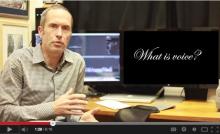Faith N. Metsan felt something begin to change in her throat one autumn afternoon. Over the next few hours, her voice just seemed to disappear. She didn’t have any other symptoms. By evening, when she tried to speak, her voice was nothing more than a whisper. Thinking this was just the beginning of laryngitis, and because work was busy, she waited for a week. When she didn’t seem to be getting better she called her primary care physician, Dr. Marcus Goodew, and made an appointment.
At Dr. Goodew’s office, his nurse recorded Faith’s blood pressure and vital signs. Then Dr. Goodew listened to her heart and lungs. He palpated her neck for swollen glands, looked into her ears, and of course, into her mouth. He asked her to open her mouth, say “ah” and lastly peered in with a small light.
He did not look at her vocal cords, either resting or vibrating. How can we infer that? The vocal cords are located around a bend in the throat. At a minimum, it takes an angled mirror, placed in the back of the mouth to see the vocal cords. Even then, the view can be quite fleeting. New technologies such as endoscopes that go through the mouth or the nose allow a more prolonged and direct view. Faith doesn’t recall anything being put in her nose or her mouth.
If Faith’s problem is with her voice, we should reasonably ask, “What is voice?” I have heard answers such as “voice is how we communicate” or “sounds that come out of our throat.” Some people have said, “the sounds our vocal cords make.” Let’s digress from her story to think about what the word voice really means.
Consider that a violin has a “voice.” A bow is pulled across the strings, they vibrate and the air inside the wood of the violin resonates, amplifying the vibrations. We hear and recognize the sound of the violin. We can say that we recognize the voice of the violin.
Effectively, any thing that vibrates in the audible range of humans has a voice, whether the horn in a car or lips placed against a trumpet’s mouthpiece. Voice is a sound produced by vibration and amplified by resonance; no vocal cords are required.
So voice consists of a sound source, that is, something vibrating (usually vocal cords in a human) and an amplifier, a resonating cavity. Faith’s complaint is that she cannot produce much of a sound, so something is wrong with the source of her vibrations. Her vocal cords presumably did not evaporate on that autumn afternoon, so her problem is with an altered or diminished vibration of her vocal cords.
Faith’s story is just one of the many anecdotes found in my recent book, “Why is There a Frog in my Throat: A Guide to Hoarseness.”

